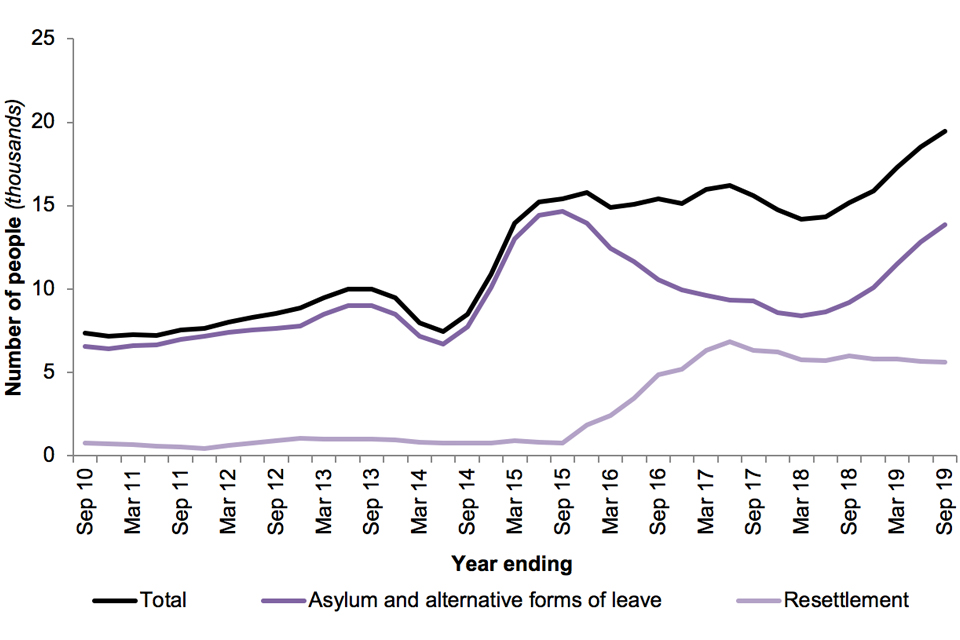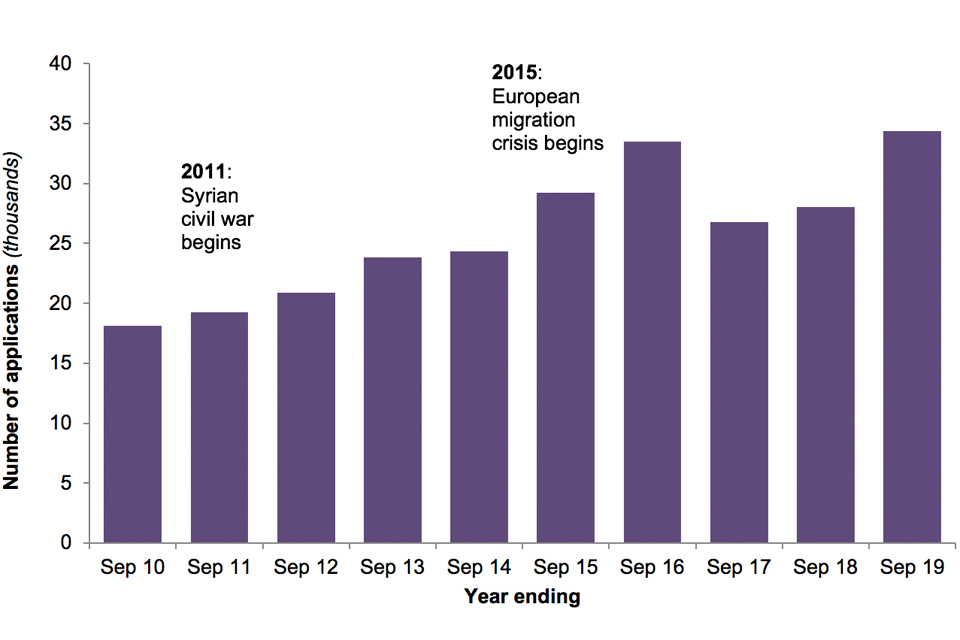How many people do we grant asylum or protection to?
Published 28 November 2019
Back to ‘Immigration Statistics, year ending September 2019’ content page.
This is not the latest release. View latest release.
Data relate to the year ending September 2019 and all comparisons are with the year ending September 2018, unless indicated otherwise. A more detailed annual summary, which also includes a cohort analysis providing the grant rates following appeal, can be found in ‘Immigration statistics, year ending June 2019’.
This section contains data on:
- Asylum applications and initial decisions, including UASC
- Resettlement
- Family reunion visas granted
- Asylum support
1. Asylum, resettlement and protection
The UK offered protection – in the form of asylum, humanitarian protection, alternative forms of leave and resettlement – to 19,480 people in the year ending September 2019 (up 28% compared with the previous year). This was the highest number of people granted protection in the UK in a single year since the year ending September 2003.
Of the 19,480 people:
- 11,596 were granted asylum (up 68%); there were notable increases in grants to Iranian (up 1,348), Sudanese (up 890), Eritrean (up 839), Turkish (up 487) and Afghan (up 464) nationals
- 1,099 were granted humanitarian protection (up 3%); over half of these (622) were granted to Libyan nationals
- 1,179 were granted alternative forms of leave following an application for asylum (down 2%)
- 5,606 were granted protection through resettlement schemes (down 6%)
Additionally, 6,035 Family reunion visas were issued to partners and children of those previously granted asylum or humanitarian protection in the UK (up 3%).
Figure 1: Grants1 of asylum, alternative forms of leave2, and resettlement3 in the UK, years ending September 2010 to 20194

Source: Asylum applications, initial decisions and resettlement – Asy_D02
Notes:
- Grants at initial decision. Actual number of grants at final decision (following appeal) will be higher.
- ‘Alternative forms of leave’ include grants of humanitarian protection, discretionary leave, grants under family and private life rules, leave outside the rules and UASC leave, that resulted from an asylum application.
- Resettlement data prior to 2013 are only available annually. Data for individual quarters in this period have been estimated by taking 25% of the annual total.
- Includes main applicants and dependants.
1.1 Resettlement
The Vulnerable Person Resettlement Scheme (VPRS) accounted for just over three-quarters (4,291) of those resettled in the UK in the year ending September 2019. Since it began in 2014, 18,252 people (mainly Syrian nationals) have been resettled under the scheme.
A further 637 people were resettled under the Vulnerable Children Resettlement Scheme (VCRS) over the last year.
Of those resettled under the VPRS and VCRS in the year ending September 2019, 238 refugees were resettled in the UK through a Community Sponsorship scheme. Since Community Sponsorship began in July 2016, 397 refugees have been resettled by community sponsor groups. Details of the scheme can be found in the ‘About the statistics’ section.
1.2 Asylum applications
There were 34,354 asylum applications in the UK (main applicants only) in the year ending September 2019, 22% more than the previous year and the highest level since the year ending June 2016, around the time of the European migration crisis. UASCs accounted for 10% of total asylum applications in the latest year.
Figure 2: Asylum applications lodged in the UK, years ending September 2010 to 20191

Source: Asylum applications, initial decisions and resettlement – Asy_D01
Notes:
- Includes main applicants only.
Table 1: Top 5 nationalities claiming asylum1, 2, 3, 4 in the UK, year ending September 2019
| Nationality | Applications | % of which are UASC | Change | Percentage change | Grant rate |
|---|---|---|---|---|---|
| Iran | 4,749 | 10% | +2,099 | +79% | 63% |
| Iraq | 3,152 | 15% | +609 | +24% | 28% |
| Albania | 3,117 | 8% | +1,415 | +83% | 19% |
| Eritrea | 2,104 | 33% | +193 | +10% | 79% |
| Pakistan | 1,919 | 2% | -277 | -13% | 28% |
| Other nationalities5 | 19,313 | 9% | +2,245 | +13% | 47% |
| Total | 34,354 | 10% | +6,284 | +22% | 48% |
Source: Asylum applications, initial decisions and resettlement – Asy_D01 and Asy_D02
Notes:
- Includes main applicants only.
- Top 5 nationalities in the year ending September 2019.
- Changes are relative to the year ending September 2018.
- Grant rate is the proportion of initial decisions which resulted in a grant of protection or other leave. Grant rate is based on year of initial decision and is not directly comparable to applications, which are based on the date the asylum application was made.
- ‘Other nationalities’ includes all nationalities that do not feature in the top 5 in the latest year.
Eurostat’s published Asylum statistics show the total number of asylum applications across the EU member states had remained stable in year ending June 2019 compared with the previous year, although there were falls in applications to Italy and Germany. Some of the UK’s near neighbours such as France, Netherlands and Belgium, along with Greece and Spain, all saw increases. The UK received the 6th largest number of applications of all EU member states in year ending June 2019; this was the 16th largest per head of the population.
In the year ending September 2019, 48% of initial decisions on asylum applications were grants of asylum, humanitarian protection or alternative forms of leave (such as discretionary leave or UASC leave), compared with 30% in the previous year.
Data from the Home Office ‘cohort’ analysis, published annually in Outcome analysis of asylum applications – Asy_D04, show that the final grant rate has typically increased to over half following appeal (based on data from 2015 to 2017). However, the final grant rate is likely to be higher than 50% for year ending September 2019, given that the grant rate at initial decision is higher than it has been in previous years.
Grant rates vary considerably by nationality as the protection requirements of specific nationalities vary, which will impact how legitimate an individual’s right to protection is deemed to be. Of those nationalities that commonly claim asylum in the UK, Libyans (95%) and Syrians (88%) typically have high grant rates at initial decision, while nationals of India (5%), China (9%) and Bangladesh (14%) typically have very low grant rates.
2. Support provided to asylum seekers
At the end of September 2019, 44,156 asylum seekers in the UK were in receipt of support under Section 95 of the Immigration and Asylum Act 1999, up 2% from the same time the previous year.
Of these, 41,214 (93%) were in receipt of both accommodation and subsistence, and 2,942 (7%) in receipt of subsistence only. The majority (82%) were located in England, with smaller supported populations in Scotland (9%), Wales (6%) and Northern Ireland (2%).
An additional 3,857 individuals were in receipt of support under Section 4 of the Immigration and Asylum Act 1999, down 5% from the previous year. A further 3,049 individuals were in receipt of support under Section 98, 46% more than the year before. Section 98 support is provided to asylum seekers on a short-term basis while their application for section 95 support is considered. The increase is likely to be linked to the increase in asylum applications in recent periods.
3. About the statistics
This section provides information on those applying for and granted protection in the UK through both asylum and resettlement routes, as well as information on the numbers in receipt of asylum support.
The data are used to assess the trends in numbers of people seeking and being granted protection, the impact of policy changes, and to understand the demographics of those coming to the UK to claim protection. Data on resettlement and support, broken down by local authority, can help local authorities understand the demands on their services and resources to aid with planning.
3.1 Asylum, resettlement and protection
The total number of individuals granted protection includes grants related to an asylum application (grants of asylum or alternative protection) and resettlement. Alternative forms of protection include humanitarian protection, discretionary leave, UASC leave, leave outside the rules, and grants under family and private life rules. Further details can be found in the user guide.
Data on asylum applications relate to the period in which the application was lodged, and initial decisions relate to the period in which the decision was made. Initial decisions may, therefore, relate to an application made in an earlier period, and thus the two are not directly comparable.
Data on initial decisions will not reflect the total number of people granted protection through asylum routes as some initial decisions may be overturned following appeal. Data on the number of appeals lodged, and their outcomes, are published in Asylum appeals lodged and determined – Asy_D06 and Asy_D07.
UASC data includes those treated as an unaccompanied minor for at least one day between the date of application and the date of initial decision. Some UASC applicants may subsequently be found to be an adult following conclusion of an age dispute. Data on age disputes are published in Asylum applications, initial decisions, and resettlement – Asy_D01 and Asy_D02.
Eurostat’s range of asylum statistics can be used for comparisons across the EU. The methodology used to compile Eurostat data differs from that used in this release. Further details can be found in the user guide.
The UK Community Sponsorship scheme was launched on 19 July 2016. The scheme allows community groups to support refugee families directly and aims to help them become self-sufficient and integrated members of the community. These figures are a subset of those published under the VPRS and VCRS and are not in addition to those resettled under these schemes. Further details can be found on Community sponsorship scheme launched for refugees in the UK.
Family reunion visas are a subset of the ‘Family: other’ visa category, published in the visa tables, of which around 99% relate to Family reunion visas. Data on Family reunion visas come from a different administrative system to other visa data so are not directly comparable. Further details can be found in the user guide.
3.2 Support provided to asylum seekers
Section 95 support is provided to destitute asylum seekers until their claim is finally determined, which may encompass either accommodation or subsistence, or both. ‘Invalid applications for support and support type not yet known’ are cases that have been deemed invalid or which have not yet been assessed.
Section 4 provides support for individuals whose claim has been refused and who have exhausted their appeal rights, but who are destitute and are temporarily unable to leave the UK.
Section 98 support provides accommodation for asylum seekers who would otherwise be destitute and who are either awaiting a decision on an application for Section 95 support or are supported under Section 95 and are awaiting transfer to their accommodation.
The data show the number of people in receipt of support on a given day, but do not show the length of time for which someone receives support or the amount of support they receive.
4. Data tables
Data referred to here can be found in the following tables:
We welcome your feedback
If you have any comments or suggestions for the development of this report, please provide feedback by emailing [email protected]. Please include the words ‘PUBLICATION FEEDBACK’ in the subject of your email.
See section 7 of the ‘About this release’ section for more details.
